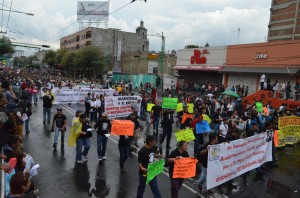 The huge demonstration on October 2, 46 years after the massacre of Tlatelolco in the Plaza of 3 Cultures in Mexico City, was marked by mourning.
The huge demonstration on October 2, 46 years after the massacre of Tlatelolco in the Plaza of 3 Cultures in Mexico City, was marked by mourning.
First was the recent death of Raúl Álvarez Garín, student leader of the ’68 movement and central to conserving the memory of the movement and the fight to punish the assassins. To that was added the lethal attack on the education students of Ayotzinapa.
And although there wasn’t a formal contingent of students from the Polytechnical Institute, on strike against top-down reforms to their curriculum, the Polytech flags waved and the school cry could be heard all along the march.
Youth in Mexico feel under attack. Their slogans, banners and signs expressed their outrage: “If they harm one, they harm us all!”, “Pain and rage for the dead of Ayotzinapa”, “We will not let history repeat itself!” “They were taken alive, we want them back alive!” “Stop the repression of students”. One hadn-written sign said, “We are not rebels, we are revolutionaries. We will keep on fighting, and we will march whenever we feel like it”.
Many signs showed the pictures and names of the disappeared students and demanded they be returned alive.
Around 6 p.m., two hours after the march began, the protesters passed Tlatelolco–scene of the 1968 massacre–toward the Palace of Fine Arts and then down 5 de mayo to the central plaza. There the main speaker, Félix Hernández Gamundi, announced that the march had filled the plaza and marchers continued to pour in. The leader of the historic movement demanded that the trial for genocide for the massacre orf 400 students in Tlatelolco againt former president Luis Echeverria be reopened.
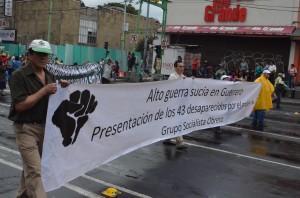 The Mexican Electricians Union joined the youth protest. The SME, by its Spanish initials, has been fighting for five years to protest the elimination of the city light company and the loss of their jobs. A group of members of the Yaqui tribe from the northern state of Sonora also joined, calling for a boycott of the companies Apasco, Ford, Coca Cola and Pepsi, beneficiaries of the illegal Independence acueduct that drains the tribe of its water supply.
The Mexican Electricians Union joined the youth protest. The SME, by its Spanish initials, has been fighting for five years to protest the elimination of the city light company and the loss of their jobs. A group of members of the Yaqui tribe from the northern state of Sonora also joined, calling for a boycott of the companies Apasco, Ford, Coca Cola and Pepsi, beneficiaries of the illegal Independence acueduct that drains the tribe of its water supply.
Nacha
Ana Ignacia Rodríguez Márquez, “Nacha”, was a member of the National Strike Committee, a leader of the student movement, a survivor of the Tlatelolco massacre and a political prisoner three times, held for two years in the Santa Martha Acatitla prison. Today she is excited:
“It’s been a long time simce I´ve seen a demonstration this big. We know that it’s because of the movement in the Polytech that has brought out so many students and people in general. This revitalizes the movement.
In 46 years we haven’t stopped demonstrating. Another thing that has brought so many people out is the homage to Raúl Álvarez Garín. The Band of Tlayacapan has come to play in his honor. I feel really sad because he was our very dear friend; now I think that the presence of his ideals goes beyond his physical disappearance and makes us all feel united. I know that I owe him a lot and I’ll keep up the fight until my last breath.”
Another cause has brought the young people into the streets, Nacha states–the brutal repression of the students of the Rural Teaching College of Ayotzinapa, Guerrero. To date, three students are dead, 43 forcibly disappeared and mass mobilizations are taking place throughout the state.
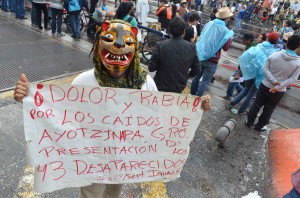 “I am from Guerrero,” she says, “and when I found out I felt enormous rage but now what they need more than anything is our support. We have to fight hard to get the students back alive, we can’t allow this, what just happened, the demand should be strong so that the studenst are returned and those responsible are punished. The governor (Angel Aguirre Rivero) has a lot of blame in this.”
“I am from Guerrero,” she says, “and when I found out I felt enormous rage but now what they need more than anything is our support. We have to fight hard to get the students back alive, we can’t allow this, what just happened, the demand should be strong so that the studenst are returned and those responsible are punished. The governor (Angel Aguirre Rivero) has a lot of blame in this.”
“Then there’s the case of Tlatlaya, with youth executed at the hands of the military. Conflicts are piling up, but this should not discourage us, with this strength we see here we have to keep up the fight.”
“I fight for Tita (Roberta Avendaño, leader of the ’68 movement) and for me. She alrady left us a while ago and we haven’t given her the recognition she deserves. We’re organizing to take her ashes to the School of Law and hold a ceremony there because those damn PRI people back then didn’t let us do it and now they have to. We’re fighting back. I just turned 70, I have diabetes, high blood pressue, and I’m still here.”
This time, Nacha didn’t march. She went straight to the Zócalo (Central Plaza) to start the meeting since she has to go to Querétaro to inaugurate an interniatonl congress of women journalists and writers. “In this shymbolic date, they will be carrying all their impressions back to the U.S.”
Nacha considers that there is a growing student movement today and affirms that many young people have joined the Committee of ’68, invited by Álvarez Garín. “They have influenced us a lot. You have to take into acccount that due to our age and illnesses, we can get a little down but they are taking the baton very well and that’s good, that thanks to our committee it can still be the committee of the youth of 68.”
Maylo
During the months of the movement, Ismael Colmenares Maguregui, Maylo, practically lived on the university campus. He liked playing guitar and in the nights joined a few other students to play Beatles or whatever. They did crazy things with the songs, destroyed them, rearranged them, had fun with it. Maylo says that one night, after being attacked by police, he began the musical meeting by changing the lyrics to the” Ballad of theVagabond”, originally by the Italian Pierantoni. And so was born “the Ballad of the Riot Cop”, the most popular parody to come out of the ’68 movement:
—Papa, papa, yesterday when I was studying I asked a man who was watching, who are you? And he said he was a riot cop. Papa, what is a riot cop? –A riot cop is an illiterate, without principles or conscience. He beats students to make a living and they only pay him for killing. –Ayayayay, we’ll never be riot cops…
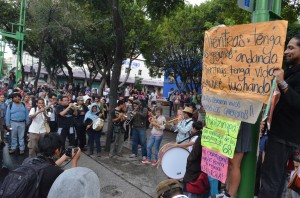 From these musical meetings a musical brigade called Los Nakos also arose.
From these musical meetings a musical brigade called Los Nakos also arose.
Today Maylo sees the national situation as a pressure cooker about to blow: “There are signs everywhere, the great success of this demonstration is one of them. The discontent is becoming widespread. The terribly neoliberal state has tried to absorb those who let themselves be coopted and at the same time savagely represses all those who resist their predatory policies. But a new generation is arising, the movement is reactivating.”
“As the young recycle hope and renew our vision of utopia, sooner or later they will permeate other layers of osciety,” he assures.
Ilia
Ilia Adad Infante Trejo is a student in the Philosophy and Literature School of the National Autonomous University of Mexico (UNAM) and also attended the 9th Vocational School so is a PolyTech student as well.
On October 2, 2013 she was arrested with 80 people near the statue of Columbus. She was falsely accused with 7 others of having destoryed an IXE bank and an OXXO store. the government was unable to show that the young people were guilty. Instead, they proved their innocence. But the city government and the judicial authorities refused to accept the proof. Ilia was sentenced to 7 years in prison. An injunction from the federal court ordered a retrial due to errors in the first process.
The judge shortly before the march reviewed the case and let them go free. Today several remain in prison. Ilia says that the judges do ridiculous things to restore the sentences with insignificant modifications. “For example, Luna Flores was tried, set free on probation, and then yesterday they re-sentenced her and only reduced the fine 1000 pesos, with a sentence of a year, three months in prison for the crime of defying authority, saying that she threw a bottle at a policeman. But it was shown on video that the arrests occurred in the middle of an attack carried out by the Ministry of Public Security, Agency 50, against the people who had gone to look for those in custody.”
Unfortunately, Ilia says, it was repression that forced her to take up the legacy of the ’68 movement. “I had been supporting the march for the memory of the movement for more than ten years, but it was the unfortunate situation I had to go through that made me organize and now I am more worthy of coming to this march, now that we are organized, that we have truly learned the lesson left us by 68”.
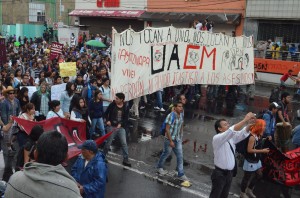 “Sixty of us were prisoners for political reasons in Mexico City, without counting those of other adminsitrations. I am working with human rights organizations in defense of our freedom.”
“Sixty of us were prisoners for political reasons in Mexico City, without counting those of other adminsitrations. I am working with human rights organizations in defense of our freedom.”
According to Ilia, there is a strategy to attack the people, not just leaders, since the war on drugs launched by Felipe Calderon. Therefore, she recommends that not only youth but all people, minorities, indigenous, and campesinos take the lesson of 68 and incorporate them into their fight.
The cry of the student movement of ’68 is still alive and relevant after 46 years. “The speakers at the rally that followed the march are talknig about political prisoners, repression disappeared, assassinations, and attacks of all kinds aganst the people of Mexico,” she states. “The same as in 1968.”



